 W
WThe Battle of Aizkraukle or Ascheraden was a battle fought on March 5, 1279, between the Grand Duchy of Lithuania, led by Traidenis, and the Livonian branch of the Teutonic Order near Aizkraukle in present-day Latvia. The order suffered a great defeat: 71 knights, including the grand master, Ernst von Rassburg, and Eilart Hoberg, leader of the knights from Danish Estonia, were killed. It was the second-largest defeat of the order in the 13th century. After this battle Duke Nameisis of the Semigallians recognized Traidenis as his suzerain.
 W
WThe Battle of Blue Waters was a battle fought at some time in autumn 1362 or 1363 on the banks of the Synyukha River, left tributary of the Southern Bug, between the armies of the Grand Duchy of Lithuania and the Golden Horde. The Lithuanians won a decisive victory and finalized their conquest of the Principality of Kiev.
 W
WThe Battle of Durbe was a medieval battle fought near Durbe, 23 km (14 mi) east of Liepāja, in present-day Latvia during the Livonian Crusade. On 13 July 1260, the Samogitians soundly defeated the joint forces of the Teutonic Knights from Prussia and Livonian Order from Livonia. Some 150 knights were killed, including Livonian Master Burchard von Hornhausen and Prussian Land Marshal Henrik Botel. It was by far the largest defeat of the knights in the 13th century: in the second-largest, the Battle of Aizkraukle, 71 knights were killed. The battle inspired the Great Prussian Uprising and the rebellions of the Semigallians, the Couronians, and the Oeselians. The battle undid two decades of Livonian conquests and it took some thirty years for the Livonian Order to restore its control.
 W
WThe Siege of Fellin took place between 25 March and 17 May 1602 during the Polish–Swedish War (1600–1611). Polish and Lithuanian forces led by Grand Crown Hetman Jan Zamoyski besieged the Swedish-held town of Fellin. The large Polish–Lithuanian army of around 5,000 troops first took the town, while the Swedish defenders, numbering around 800, retreated to the city's castle. After a second frontal attack on the castle, during which the Voivode of Wenden Jerzy Farensbach was killed, the Swedish garrison capitulated, although a group of Finnish soldiers refused to surrender and blew themselves up in the castle's tower. Fellin was later recaptured by the Swedes in the siege of 1608.
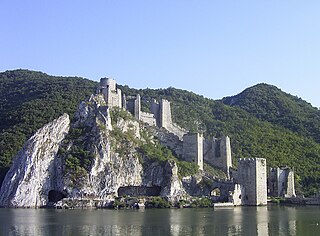 W
WThe siege of Golubac was a military conflict between the Hungarian–Wallachian–Lithuanian alliance and the Ottoman Empire in May 1428. This siege was the first battle in Hungarian military history in which the Hungarian army used significant artillery. However, they could not capture Golubac and were defeated by the Ottoman main army, led by Sultan Murad II. After the battle, most of Serbia and Bosnia was conquered by the Ottoman Army.
 W
WThe Battle of Górzno was a battle fought during the ending phase of the Polish–Swedish War (1626–1629), between Sweden and the Polish–Lithuanian Commonwealth on 12 February 1629. The Swedes were commanded by Herman Wrangel, and the Poles by Stanisław Rewera Potocki. The battle ended with a victory for Sweden, who forced the entrenched Polish army out of their positions and retreat.
 W
WThe Battle on the Irpin River is a semi-legendary battle between the armies of the Grand Duchy of Lithuania and Principality of Kiev. According to the story, Gediminas, the Grand Duke of Lithuania, conquered Volhynia before turning his attention to Kyiv. He was opposed by Prince Stanislav of Kiev allied with the Principality of Pereyaslavl and Bryansk. Lithuanians achieved a great victory and extended their influence to Kyiv. There are no contemporary sources attesting to the battle. It is known only from late and generally unreliable Lithuanian Chronicles. Therefore, historians disagree whether it was an actual battle in the early 1320s or a fictional story invented by later scribes. Lithuanians gained full control of the city only in 1362 after the Battle of Blue Waters against the Golden Horde.
 W
WThe Battle of Karuse or Battle on the Ice was fought on 16 February 1270 between the Grand Duchy of Lithuania and the Livonian Order on the frozen Baltic Sea between the island of Muhu and the mainland. The Lithuanians achieved a decisive victory. The battle, named after the village of Karuse, was the fifth-largest defeat of the Livonian or Teutonic Orders in the 13th century. Almost all that is known about the battle comes from the Livonian Rhymed Chronicle, which devoted 192 lines to the battle.
 W
WThe Battle of Kircholm was one of the major battles in the Polish–Swedish War (1600–1611). The battle was decided in 20 minutes by the devastating charge of Polish-Lithuanian cavalry, the Winged Hussars. The battle ended in the decisive victory of the Polish-Lithuanian forces, and is remembered as one of the greatest triumphs of Commonwealth cavalry.
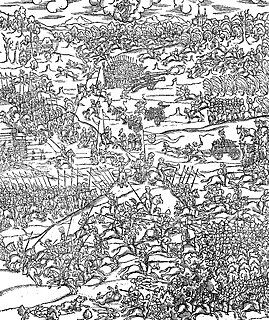 W
WThe Battle of Kletsk was a battle fought on 5 August 1506 near Kletsk, between the army of the Grand Duchy of Lithuania, led by Court Marshal of Lithuania Michael Glinski, and the army of the Crimean Khanate, led by Fetih I Giray and Burnaş I Giray, sons of the Khan of Crimea, Meñli I Giray. The battle was one of the first and greatest Lithuanian victories over the Tatars.
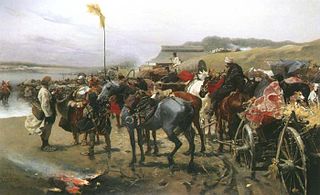 W
WThe Battle of Olkieniki took place on November 18, 1700, during the Lithuanian Civil War, between forces of the Sapieha family, led by Michał Franciszek Sapieha, and an anti-Sapieha coalition of Wiśniowiecki, Ogiński, Radziwiłł and Pac families and their supporters, led by Michał Serwacy Wiśniowiecki.
 W
WThe Siege of Opochka was an unsuccessful attempt by the Grand Duchy of Lithuania and the Kingdom of Poland to conquer the Muscovite fortress of Opochka during the Fourth Muscovite–Lithuanian War.
 W
WThe Battle of Orsha, was a battle fought on 8 September 1514, between the allied forces of the Grand Duchy of Lithuania and the Crown of the Kingdom of Poland, under the command of Hetman Konstanty Ostrogski; and the army of the Grand Duchy of Moscow under Konyushy Ivan Chelyadnin and Kniaz Mikhail Golitsin. The Battle of Orsha was part of a long series of Muscovite–Lithuanian Wars conducted by Muscovite rulers striving to gather all the former Kievan Rus' lands under their rule.
 W
WPilėnai was a hill fort in the Grand Duchy of Lithuania. Its location is unknown and is subject to academic debates, but it is well known in the history of Lithuania due to its heroic defense against the Teutonic Order in 1336. Attacked by a large Teutonic force, the fortress, commanded by Duke Margiris, tried in vain to organize a defense against the larger and stronger invader. Losing hope, the defenders decided to burn their property and commit mass suicide to deprive the Order from prisoners and loot. This dramatic episode from the Lithuanian Crusade has caught the public imagination, inspired many works of fiction, and became a symbol of Lithuanian struggles and resistance.
 W
WThe Siege of Polotsk was laid in 1518 by forces of the Grand Duchy of Moscow on Polotsk during the Fourth Muscovite–Lithuanian War (1512–1522). The Lithuanians defended the city. According to a legend, Prince Casimir Jagiellon appeared before the Lithuanian troops and helped them to achieve victory. It was the first miracle attributed to Casimir, which perpetuated his cult and led to his eventual canonization.
 W
WThe siege of Pskov, known as the Pskov Defense in Russia, took place between August 1581 and February 1582, when the army of the Polish king and Grand Duke of Lithuania Stephen Báthory laid an unsuccessful siege and successful blockade of the city of Pskov during the final stage of the Livonian War of 1558–1583.
 W
WThe Battle of Saladen was a battle that took place on 19 March 1703 near Saločiai, Lithuania during the Great Northern War. The Swedes won the battle.
 W
WThe Battle of Salis took place during the Polish–Swedish War (1600–1611) during the night of March 23–24, 1609. After the capture of Pärnu, Jan Karol Chodkiewicz, commander of the Lithuanian army, moved towards Riga, which was besieged by the Swedes under the command of Joachim Frederick von Mansfeld. Along the way, Chodkiewicz saw a chance to destroy the Swedish squadron based in the Salis port which blocked Riga. The dominant presence of the Swedes in the Baltic region gave the Lithuanian army the upper hand, as von Mansfeld and the Swedish army did not expect the possibility of an attack in such a heavily Swedish-occupied region.
 W
WThe Battle of Saule was fought on 22 September 1236, between the Livonian Brothers of the Sword and pagan troops of Samogitians and Semigallians. Between 48 and 60 knights were killed, including the Livonian Master, Volkwin. It was the earliest large-scale defeat suffered by the orders in Baltic lands. The Sword-Brothers, the first Catholic military order established in the Baltic lands, was soundly defeated and its remnants accepted incorporation into the Teutonic Order in 1237. The battle inspired rebellions among the Curonians, Semigallians, Selonians, Oeselians, tribes previously conquered by the Sword-Brothers. Some thirty years' worth of conquests on the left bank of Daugava were lost. To commemorate the battle, in 2000 the Lithuanian and Latvian parliaments declared September 22 to be the Baltic Unity Day.
 W
WThe Battle of Stångebro, or the Battle of Linköping, took place at Linköping, Sweden, on 25 September 1598 (O.S.) and effectively ended the personal union between Sweden and the Polish–Lithuanian Commonwealth, that had existed since 1592. In the battle, an army of c. 8, 000–12,000 commanded by Duke Charles defeated a mixed force of c. 5,000–8,000 consisting of an invading army of mercenaries in the king's employ and diverse but poorly co-ordinated supporting Swedish noblemen's forces commanded by King of both Sweden and the Polish–Lithuanian Commonwealth Sigismund III Vasa, who was acting to maintain and restore his personal union against anti-Catholic forces in Lutheran Sweden. The Swedish king's general Constantin fought at the western bridge.
 W
WThe Battle of Ula or Battle of Chashniki was fought during the Livonian War on 26 January 1564 between the Grand Duchy of Lithuania and the Tsardom of Russia on the Ula River north of Chashniki in the Vitebsk Region. The Russian troops, unarmed and moving in a loose formation, were taken by complete surprise and defeated, losing their large wagon train.
 W
WThe Battle of Ustechko was fought during the Polish–Ottoman War (1683–1699), between the armies of the Polish–Lithuanian Commonwealth on the one hand and of Khanate of Crimea and Ottoman Empire on the other. Polish–Lithuanian Commonwealth forces under the command of Stanisław Jan Jabłonowski defeated the Tatars and Ottomans forces commanded by Şehbaz Giray.
 W
WThe Battle of Varna took place on 10 November 1444 near Varna in eastern Bulgaria. The Ottoman Army under Sultan Murad II defeated the Hungarian–Polish and Wallachian armies commanded by Władysław III of Poland, John Hunyadi and Mircea II of Wallachia. It was the final battle of the Crusade of Varna.
 W
WThe Battle of the Vedrosha River was a battle in the course of the Russo-Lithuanian war of 1500–1503 which ended with a decisive Russian victory and proved to be of strategic significance. It was carried out on 14 July 1500, some 50 km to the west of Kaluga, between forces of the Grand Duchy of Lithuania, under command of Prince Konstantin Ostrozhsky and Russian (Muscovite) army under Prince Daniil Shchenya.
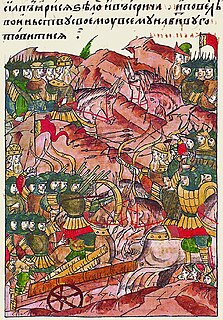 W
WThe Battle of the Vorskla River was a great battle in the medieval history of Eastern Europe. It was fought on August 12, 1399, between the Tatars, under Edigu and Temur Qutlugh, and the armies of Tokhtamysh and Grand Duke Vytautas of Lithuania. The battle ended in a decisive Tatar victory.
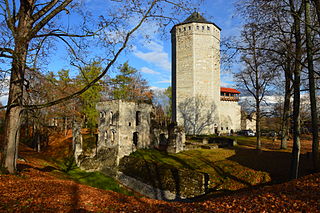 W
WThe Siege of Weissenstein took place between 31 May and 30 September 1602, during the Polish–Swedish War (1600–11). Two weeks after the capture of Fellin, Grand Crown Hetman Jan Zamoyski led the Polish-Lithuanian army of 2,000 troops to besiege Weissenstein. Weissenstein, a major transportation hub in Estonia, was a site of strategic importance to both Poland and Sweden. Located among the marshes and built during the Teutonic period, the castle had strong artillery and was defended by 700 soldiers, local peasants, and townspeople. Weissenstein was a walled city with 30-meter towers at the corners and high bastions, and thus presented the attacking force with a significant barrier to success, even with siege works.
 W
WThe Battle of Wilkomierz took place on September 1, 1435, near Ukmergė in the Grand Duchy of Lithuania. With the help of military units from the Kingdom of Poland, the forces of Grand Duke Sigismund Kęstutaitis soundly defeated Švitrigaila and his Livonian allies. The battle was a decisive engagement of the Lithuanian Civil War (1432–1438). Švitrigaila lost most of his supporters and withdrew to southern Grand Duchy; he was slowly pushed out and eventually made peace. The damage inflicted upon the Livonian Order has been compared to the damage of Battle of Grunwald upon the Teutonic Order. It was fundamentally weakened and ceased to play a major role in Lithuanian affairs. The battle can be seen as the final engagement of the Lithuanian Crusade.
 W
WThe Battle of Wisniowiec took place on 28 April 1512.